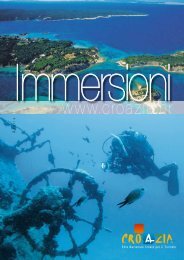Diving
Diving
Diving
Create successful ePaper yourself
Turn your PDF publications into a flip-book with our unique Google optimized e-Paper software.
ZADAR<br />
In Dalmatia it is the Zadar area which is richest in islands and<br />
the advantage of this type of aquatorium is that regardless<br />
of weather conditions a location well protected from winds<br />
and waves can be found for safe diving. Waters around the<br />
island of Pag conceal a considerable number of shipwrecks,<br />
but at greater depths (over 40m), which are inaccessible for<br />
diving using compressed air, but which are now accessible<br />
for divers able to use gas mixtures for deep sea diving<br />
(technical diving). However, this form of diving demands a<br />
great deal of experience, training and professionalism, and<br />
only a relatively small number of divers engage in it. Apart<br />
from its complexity, the cost of the gas preparation needed<br />
for diving at great depths is still beyond the reach of the<br />
wider diving population. Consequently, the expansion of<br />
diving tourism and its supply continues to crucially depend<br />
on the accessibility of locations not exceeding 40 m in depth<br />
(optimum depth for diving using compressed air).<br />
Thousands of years of history have<br />
left their traces on the Adriatic’s sea bed:<br />
countless attractive wrecks of ships<br />
∆<br />
∆ Remains of Roman shipwrecks in the<br />
Adriatic Sea are among the last in Europe to<br />
become accessible<br />
Pag<br />
Croatian National Tourist Board 23




